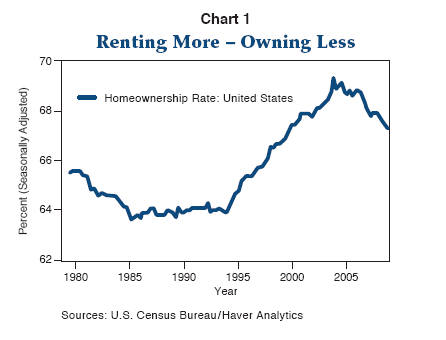 Like your average government foray into the housing market, the first-time homebuyer credit produced noticeable economic distortions while opening opportunities for creative borrowers of the ‘M. Mouse’ variety. Today’s Mortgage Bankers Association numbers showed an October drop of 12% to the lowest level in 9 years as Congress deliberated extending the homebuyer credit and prospective homeowners. Such a modest short term dislocation is a far cry from good ol’ days of FNM and FRE jamming credit down the throats of every underqualified borrower they could find so it could be neatly packaged up in a securitized muddle sold to underqualified investors in Asia and Europe. The effect of this gargantuan effort was to insure that a full 69% of the citizenry was able to achieve the American dream, which was nicely distilled into owning a poorly-built single family home in a cookie cutter subdivision. This chart, which shows the rapid retreat towards a more traditional 65% figure, was posted a few months back and comes to us courtesy of O.C. cast member Bill Gross:
Like your average government foray into the housing market, the first-time homebuyer credit produced noticeable economic distortions while opening opportunities for creative borrowers of the ‘M. Mouse’ variety. Today’s Mortgage Bankers Association numbers showed an October drop of 12% to the lowest level in 9 years as Congress deliberated extending the homebuyer credit and prospective homeowners. Such a modest short term dislocation is a far cry from good ol’ days of FNM and FRE jamming credit down the throats of every underqualified borrower they could find so it could be neatly packaged up in a securitized muddle sold to underqualified investors in Asia and Europe. The effect of this gargantuan effort was to insure that a full 69% of the citizenry was able to achieve the American dream, which was nicely distilled into owning a poorly-built single family home in a cookie cutter subdivision. This chart, which shows the rapid retreat towards a more traditional 65% figure, was posted a few months back and comes to us courtesy of O.C. cast member Bill Gross:

While some, including Jeff Matthews (who may or may not be making this up), are bullish on the sector and see enormous opportunity, others are less sanguine about the near-term future for the American homebuilding sector. I would fall into the latter category.
Let’s try and forget the speculative flipping and fraud that boosted the market at the margin (this seems to be the Congress’ preferred mode of thought) and pretend there wasn’t any excess construction. Back of the envelope calculations suggest that hitting the 65% rate would imply around 4.7 mm homes that will be rendered excess- that alone is roughly equal to the number of homes completed in the US from 2006-2008. Apartment vacancies have also risen to historically high levels during a period of declining home ownership, which would also add support to the idea that there is a massive overcapacity of housing stock for the time being.
Thanks to a government strategy to limit damage to the economy by recreating the turbocharged leverage of the mid-2000’s bull market, money is once again astoundingly cheap. The average 30-year fixed mortgage rate at around 4.90% allows the American borrower credit at a slim 50 bps behind the full faith and credit of the US government. That this rate underprices the risk of long-term lending 30 year seems to be a bit of an understatement while more than 300,000 a homes a month slide into foreclosure. Politically directed credit flows generally don’t have the best track record, and with rates at such stimulative levels I don’t see this ending well.

Anecdotal observation notes that home-flipping infomercials seem to be recession proof and there are still legions of Americans making millions working from home a few hours a week. Is it impossible to suggest that America’s aspiring real-estate investor class has returned for a second round of speculative buying?
Your average American is keenly aware of the massive bust in housing and is accustomed to sharply rising real estate prices, having witnessed the spectacular accident of long term appreciation of home prices. Your average fellow, never the most astute market participant, generally seems to retain the belief that real estate is a great long-term investment. Its tangible and ‘they aren’t making any more of it’, and a less than stellar decade in the markets has turned many retail buyers off of financial assets. With rates at pre-collapse levels and prices well off their peak, I would not be shocked to learn that more than a fair share of amateur Donald Trumps who missed out on the first round have been buying distressed properties as ‘investments’.
While isolated pockets of the nation will likely enjoy robust and relatively durable residential real-estate recoveries owing to local agglomeration economies (say, portions of Manhattan, the nicer bits of Silicon Valley, etc.), the large part of America is likely to continue below-trend housing growth for the foreseeable future. While I’d agree with Herr Matthews on the bullish near-term prospects, I would do so more on a belief that the Federales have successfully reinflated a highly speculative bull market that has raged for years. In doing so they are forestalling the inevitable: fundamentally, this is a sector that remains grossly overbuilt and is headed for a period of secular low growth after it slowly and painfully works off the enormous excess capacity. Unless you believe the future will resemble the pre-2008 past, I would seek greener pastures.
-bleichröder

Leave a comment